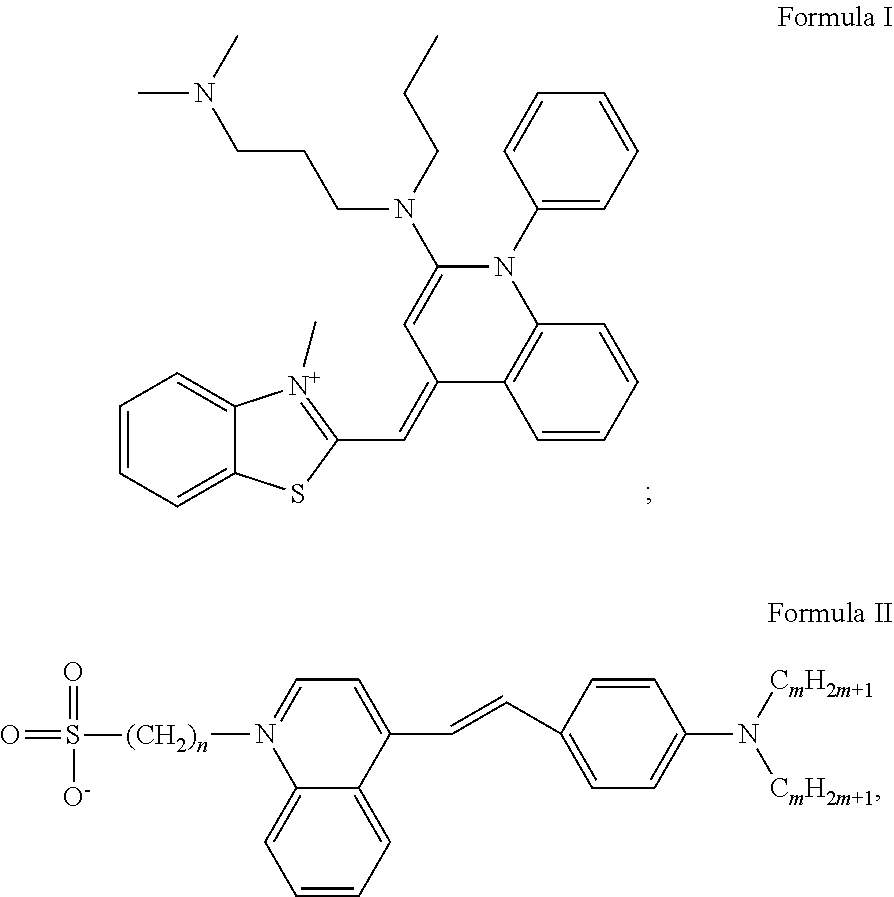Method for visualizing biomolecules, such as proteins or nucleic acids, with the unaided eye, without needing to use potentially toxic compounds, exposure to ultraviolet (UV) light or fluorescence
a biomolecule and visualization technology, applied in the field of biomolecule visualization, can solve the problems of difficult handling, very little use of strategies, and loss of millions of dollars in this crop
- Summary
- Abstract
- Description
- Claims
- Application Information
AI Technical Summary
Benefits of technology
Problems solved by technology
Method used
Image
Examples
examples of application
Example 1
[0042]a) For separating DNA, this molecule was placed together with a loading solution (0.25% bromophenol blue, 0.25% xylene cyanol and 30% glycerol). This solution was then placed in an agarose matrix in a solution containing 1×TAE buffer (40 mM Tris, 20 mM acetate and 1 mM EDTA). By applying a voltage difference to the gel, the DNA migrates to the positive pole and DNA molecules are separated as they pass through the matrix according to their different sizes.[0043]b) The matrix was then placed in a container with cyanine-derived DNA intercalating molecule SYBR® Green I (N′,N′-dimethyl-N-[4-[(E)-(3-methyl-1,3-benzothiazol-2-ylidene)methyl]-1-phenylquinolin-1-ium-2-yl]-N-propylpropane-1,3-diamine) at a concentration of 1.96 μM (INVITROGEN®, diluted 10,000 fold, i.e., 1× final dilution) the gel completely covered in 1×TAE buffer for approx. 30 min. The container containing the gel was protected from light by covering with an aluminum foil. The gel was put under shaking at le...
example 2
[0049]a) For visualizing proteins, these molecules were placed onto a polyacrylamide matrix and the electrophoresis process was carried out.[0050]b) The gel was placed in a container containing the intercalating agent SYPRO® red (protein gel stain) at a concentration of 3.92 μM (INVITROGEN®, 5000 fold dilution) and 7.5% (v / v) acetic acid. It was covered with aluminum foil to protect the intercalating agent from light. The gel was incubated for 30 min shaking at less than 50 rpm at room temperature.[0051]c) The gel was removed and rinsed in 7.5% acetic acid to remove the excess of SYPRO® red (protein gel stain) from its surface and placed in 0.19 mM NBT for at least 90 min.[0052]d) The gel was removed from this solution and the NBT residues were removed with distilled water.[0053]e) Protein bands were visualized by the naked eye and without the need to exposure to UV light.
example 3
[0054]a) For separating RNA, this molecule was placed together with a loading solution (0.25% bromophenol blue, 0.25% xylene cyanol and 15% ficoll). This solution was then placed onto a polyacrylamide matrix in a solution containing 1×TAE buffer (40 mM Tris, 20 mM acetate and 1 mM EDTA). By applying a voltage difference to the gel, the RNA migrates to the positive pole and RNA molecules are separated as they pass through the matrix according to their different sizes.[0055]b) The matrix was then placed in a container with the cyanine-derived RNA intercalating molecule SYBR® Green II (RNA cyanine dye) at a concentration of 1.96 μM (INVITROGEN®, 10,000 fold dilution, i.e. 1× final dilution) the gel completely covered in 1×TAE buffer for approx. 30 min. The container containing the gel was protected from light by covering with an aluminum foil. It was put under shaking at less than 50 rpm and at room temperature for 30 min.[0056]c) The gel was placed in a container containing 0.198 mM o...
PUM
| Property | Measurement | Unit |
|---|---|---|
| temperature | aaaaa | aaaaa |
| concentration | aaaaa | aaaaa |
| fluorescence | aaaaa | aaaaa |
Abstract
Description
Claims
Application Information
 Login to View More
Login to View More - R&D
- Intellectual Property
- Life Sciences
- Materials
- Tech Scout
- Unparalleled Data Quality
- Higher Quality Content
- 60% Fewer Hallucinations
Browse by: Latest US Patents, China's latest patents, Technical Efficacy Thesaurus, Application Domain, Technology Topic, Popular Technical Reports.
© 2025 PatSnap. All rights reserved.Legal|Privacy policy|Modern Slavery Act Transparency Statement|Sitemap|About US| Contact US: help@patsnap.com



